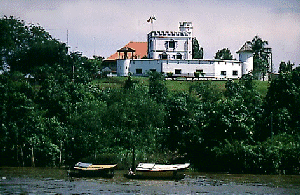
Most of Kuching's historic buildings are the legacy of the WhiteRajahs, James, Charles and Vyner Brooke, although some fine buildingswere constructed by the Malay and Chinese communities. Kuching'sarchitectural heritage is far better preserved than that of manySoutheast Asian cities, and most of the important buildings canbe seen on a walking tour of the city centre.
Main Bazaar, the city's oldest street, is a row of well-preserved19th Century Chinese shophouses that comprise the old commercialand residential heart of Kuching. Other good examples of Chineseshophouse architecture are the nearby Carpenter Street and IndiaStreet.
The Square Tower, on the Kuching Waterfront, is a stonefort built by Charles Brooke in 1879 to guard the city from maraudingpirates. It replaced a wooden fort burnt down in 1857 during theGold Miners' Rebellion, in which the first White Rajah, JamesBrooke, nearly lost his life.
Fort Margherita, on the opposite bank of the river, wasbuilt at the same time, and for the same purpose. It was namedfor Charles Brooke's wife, the Ranee Margaret. Nowadays it housesa police museum.
The Courthouse Complex was the first seat of Sarawak'sgovernment, and was built in an unusual Colonial-Classical stylein 1871. It features magnificent belian (ironwood) roofsand interior detailing from some of Sarawak's finest craftsmen.The Baroque-style Clock Tower was added in 1883. In front of theCourthouse there is a memorial to Rajah Charles Brooke.
The Pavilion and the Round Tower are located nextto the Courthouse. The pavilion is an unusual study in Frenchcolonial architecture that would not look out of place in Louisianaor Guadeloupe. The Round Tower was planned as a fort but nevercompleted, instead housing government offices.
The Main Post Office gives Pos Malaysia the unique distinctionof owning what is probably one of the most unusual and attractivepost offices anywhere in the world. It was built in 1931, butappears to belong to a much earlier age with its airy halls andneo-classical facade.
The Istana is the official residence of the Governor, theHead of State of Sarawak, and was previously the royal seat ofthe White Rajahs. It was built in 1870 by Charles Brooke in responseto his wife's insistence that a wooden house was not a fittinghome for a man of his stature. It also features superb belian roofs and fine interior detailing.